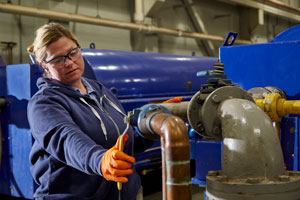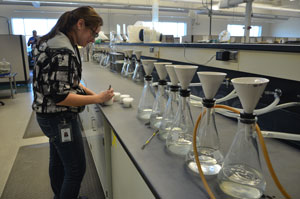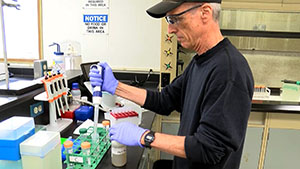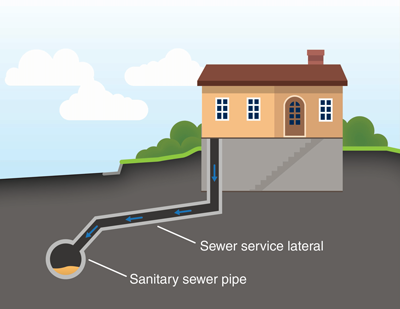Protecting Public Health

Clean water and a clean environment are essential to a healthy life, and the Metropolitan Council's Environmental Services division is committed to both. Our work supports a sustainable water supply now and in the future. While many public, private, and nonprofit organizations have a role in protecting water quality, the Met Council is responsible under state law for developing an overall approach to water planning and management for the region.
 126 years of compliance excellence for clean water
126 years of compliance excellence for clean water
Peak Performance awards are measurable proof that Environmental Services is ensuring clean water for future generations. Our nine wastewater treatment plants continue to earn high honors for outstanding compliance with federal clean water discharge permits. For their performance in 2022, all nine plants were recognized with Peak Performance Awards by the National Association of Clean Water Agencies. Seven plants earned Platinum Awards for achieving five or more consecutive years of full compliance with their permits:
- Hastings (31 years)
- St. Croix Valley (30 years)
- Blue Lake (16 years)
- Eagles Point (16 years)
- Empire (14 years)
- Metro (10 years)
- Seneca (5 years)
Our treatment plants consistently outperform our peers. Of the facilities nationwide being recognized by NACWA for perfect performance, only 34% achieved platinum level awards. For our nine plants, 77% reached this high level of performance.
The compliance records at the Hastings and St. Croix Valley Plants place them among the top five plants in the nation.
 Ensuring healthy waters with frequent testing
Ensuring healthy waters with frequent testing
Our Laboratory Services team plays a pivotal role in ensuring we meet or exceed environmental quality standards. In 2022, the team analyzed 48,000 water and wastewater samples:
- 62% ensured our wastewater treatment plants met permit and process control requirements
- 24% supported external partners in their environmental monitoring of lakes, rivers, and streams
- 8% supported our direct waterbody monitoring
- 5% supported industrial pretreatment requirements
- 1% supported other internal Environmental Services groups
COVID-19 wastewater analysis leads research efforts
“Just want to say how much I appreciate your web page on COVID-19 in wastewater. I have looked at it regularly for months to get accurate local data on COVID. The information itself is a great service and a great example of collaboration with the U of M.”
— Martha Hewett, resident
Research scientists at our Metro Plant continued to monitor levels of the SARS-CoV-2 viral material entering the plant in wastewater in 2022, leading the way for other researchers in this area. Viral load in sewage has emerged as an important indicator of the prevalence of COVID-19 in the population served by our wastewater system, often before community testing shows the same trends. ES partners with the University of Minnesota Genomics Center on the research. We also provided wastewater samples to several state and national studies.
After receiving media attention about the Metro Plant’s research on wastewater influent as an indicator of the amount of viral RNA in the sewershed, the Met Council formed a team to push out weekly data to the public. Beginning in January 2022, we collected samples at the Metro Plant, took them to the Genomics Center at the University of Minnesota for analysis, interpreted, plotted, and updated the data on a web page, and pushed out the results weekly on social media for public consumption. Wastewater surveillance allowed the public to see the amount of virus in circulation more accurately.
 Wastewater treatment plants recognized with Minnesota Department of Health Appreciation Award
Wastewater treatment plants recognized with Minnesota Department of Health Appreciation Award
The Minnesota Department of Health recognized Environmental Services and each wastewater treatment plant for "the persistent and sustained effort" to support Minnesota's COVID-19 response. In addition to the 24/7 work of plant operators and staff that kept the plants running effectively and ensured clean water for local communities, our wastewater treatment plants also provided wastewater samples to several state and national studies. These samples contributed to groundbreaking research efforts to track COVID-19 through water and wastewater sources.
 Preventing inflow and infiltration with new financial assistance
Preventing inflow and infiltration with new financial assistance
Environmental Services worked with a task force of staff from cities and townships in the metro area to develop a grant program that will provide funds to repair private sewer pipes that connect homes to local sewer mains and are causing inflow and infiltration (I/I). The task force included representatives from Apple Valley, Bloomington, Chanhassen, Columbia Heights, Cottage Grove, Eagan, Edina, Golden Valley, Lauderdale, Minneapolis, Mound, Newport, Saint Paul, St. Anthony, West St. Paul, and White Bear Township.
I/I is clear water – stormwater and groundwater – that enters the wastewater system. It can overload the system and cause costly sewer backups into homes and buildings. Excess I/I can also damage pipes and treatment systems and cause sewer overflows into rivers and lakes.
Private property owners will soon have access to funding to repair these sewer pipes. This assistance builds on a program we already have in place to help cities and townships with aging and broken pipes. Reducing I/I will maintain the integrity of the wastewater system and the health of its users and the environment.